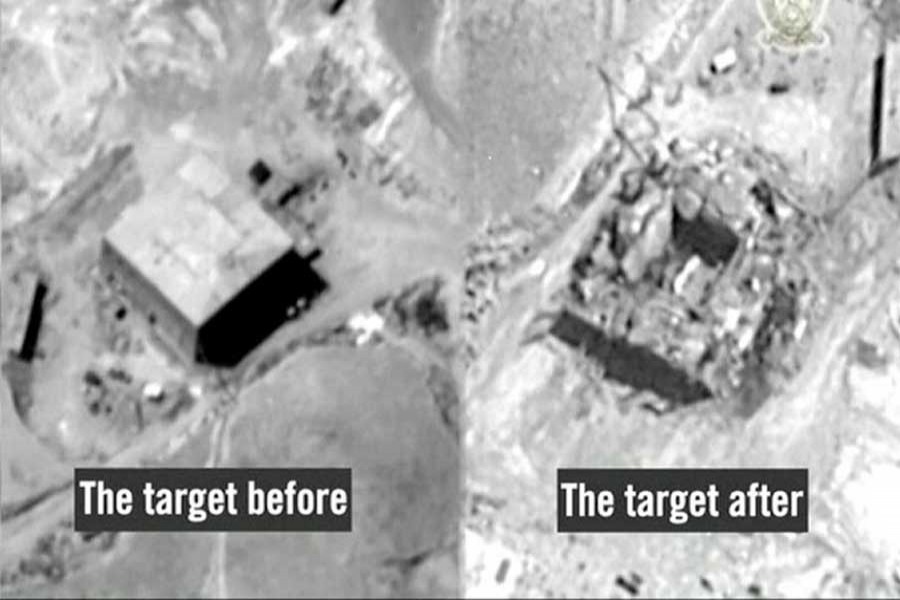Israel for the first time confirmed that it bombed a suspected Syrian nuclear reactor in 2007, saying on Wednesday that the strike removed a major threat to Israel and the region and was a “message” to others.
The first public acknowledgement by Israel that its F-16 and F-15 warplanes carried out the September 6, 2007, bombing of the partially constructed Al-Kubar facility near Deir al-Zor was made after military censors lifted a more than 10-year order that had barred Israeli officials from discussing it.
The strike had already been extensively reported abroad, and discussed by US officials. Israel, however, kept quiet to avoid provoking Syrian reprisals and a possible regional war.
The Israeli military released newly declassified operational footage, photographs and intelligence documents about the bombing and detailing the intelligence operation that led up to it.
Israel concluded that the reactor had been under construction with North Korean help and was months away from activation. Reuters has been unable to immediately verify the Israeli material.
Israel’s decision to go public comes after repeated calls in recent months by Prime Minister Benjamin Netanyahu for the United States and international community to take tougher action on Syria’s ally, Iran.
“The motivation of our enemies has grown in recent years, but so too the might of the IDF (Israel Defence Forces),” Israeli Defence Minister Avigdor Lieberman said on Wednesday.
“Everyone in the Middle East would do well to internalise this equation,” he said.
The Israeli military described in detail the events leading up to the night of September 5 to September 6, 2007, in which, it said, eight warplanes took off from the Ramon and Hatzerim air bases and flew to Deir al-Zor region, 450 km northwest of Damascus, Syria, and dropped 18 tonnes of munitions.
The operation was launched after it received intelligence indicating that “a substantial threat to Israel and the region, in the form of a nuclear reactor, was being built in Syria”.
US backing
In his 2010 memoir “Decision Points,” former US President George W. Bush disclosed that he discussed intelligence about the Syrian facility with then Israeli Prime Minister Ehud Olmert before it was destroyed but did not give him the green light for the raid.
James Jeffrey, Bush’s deputy national security adviser, said on Wednesday that the former US president had been “absolutely supportive” of Israel.
“(He) made it clear that we were very happy that events had eliminated this threat and that if there were any threats to Israel that would emerge from this situation, the United States would stand with Israel, period,” Jeffrey told Israel’s Army Radio.
“Top secret”
The Israeli military declassified internal “top secret” intelligence reports, in Hebrew, some of them partly redacted.
One, dated March 30, 2007, said: “Syria has set up, within its territory, a nuclear reactor for the production of plutonium, through North Korea, which according to an (initial) worst-case assessment is liable to be activated in approximately another year. To our assessment [REDACTED] secretive and orderly [REDACTED] for achieving a nuclear weapon.”
Israeli intelligence predicted that the suspected reactor “would turn operational by the end of 2007”.
The mission to destroy the facility started at 10.30 pm on September 5 and ended with safe return of the warplanes at 2.30 a.m. the next day, the Israeli military said.
As it happened, the event was first made public by Syria, which, as reported by Reuters at the time, said in the early hours of September 6 that Syrian air defences had repelled an incursion by Israeli warplanes.
Syria, a signatory of the 1970 nuclear Non-Proliferation Treaty, has always denied that the site was a reactor or that Damascus engaged in nuclear cooperation with North Korea.
According to Reuters, the Israeli military announcement on Wednesday noted that the area in question, around Deir al-Zor, was captured by Islamic State after the Syrian civil war erupted in 2011.
Had there been an active reactor there, the Israeli military said, it would have had “severe strategic implications on the entire Middle East as well as Israel and Syria”.
The Israeli release contains a black-and-white aerial photograph captioned “before the attack” and showing a box-like square structure amid desert dunes with smaller outlying buildings.
A series of black-and-white videos, taken above the target, shows the structure in cross-hairs. A male voice is heard counting down three seconds, a cloud of black smoke rises from the centre of the structure as it explodes. Other footage appears to show the aftermath - a smouldering hole in the ground.
Wednesday’s release came ahead of the publication of a memoir by Olmert. One of his aides told Reuters the book would contain passages about the 2007 strike in Syria.


